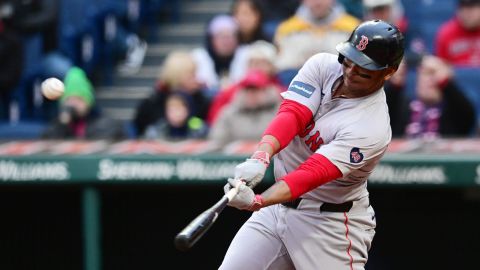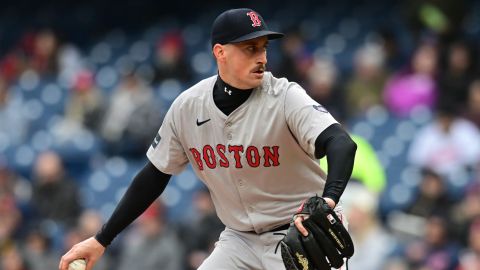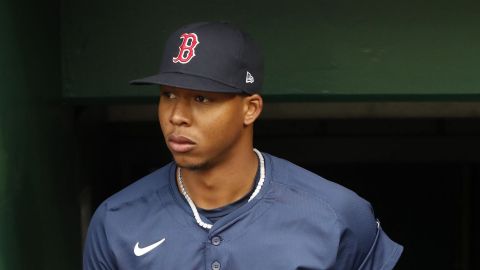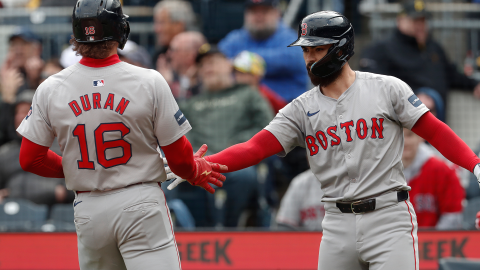The Boston Red Sox are a team rich in history and have provided fans with memories that will last a lifetime. One man with all these memories at his fingertips is Dick Bresciani, vice president/emeritus and team historian of the Red Sox.
Bresciani has held a number of different positions in his 39 years with the Red Sox and has become an invaluable member of the organization.
NESN.com: You’ve been with the Red Sox for close to 40 years. How did you originally get your start here?
Dick Bresciani: It’s been a really great journey with the Red Sox because of all the terrific people, players and officials that have been here since I came in 1972. I had been working at the University of Massachusetts, my alma mater, in the athletic department in sports information.
After 10 years there, I decided I should be looking to further myself. I wanted to get into professional baseball, and there were major league teams that were beginning to expand their public relations department. So I wrote to a whole bunch of teams and got a lot of rejection letters. I finally heard back from the Red Sox. They said to get back in touch with them because there wasn’t anything available at that time, and I did.
Then all of a sudden, there was a potential opening here because the assistant in PR was going to be interviewed by the Milwaukee Brewers for their head job. So I came in for an interview, and they finally said if he takes that job, will you take this one, and I said absolutely. Two weeks later, they called me up on a Thursday night and said can you be here Saturday and join the team. So I came on Memorial Day weekend of 1972 and when we finished on Memorial Day, I left with the team on a two-week, four-city trip, so I was thrown right into it.
NESN.com: What other jobs have you held since you started?
DB: I started as an assistant in PR when we were a very small organization, and there were only 34 full-time people in the office. We were everything in those days, and we had to do it all, but it was a much smaller scale. We started to grow at the end of the ’70s, and I became the director of publicity for the team, and then later on, I became the head of public relations/vice president.
I ran public relations mainly on the baseball side for about 25 years. So I went through a lot of great teams, a lot of great players and wonderful moments even though we couldn’t get that final out a couple of times to win the World Series, but it was still a great ride. So up until the late 1990s, I was in charge of PR. After that, I was in public affairs as vice president and worked with a variety of things in publications, archives and records, and now I’m kind of in charge of the history of the ball club.
I still work with a lot of documentaries, television people, films and things that have to do with the Red Sox when they come in and need information on the past. I’m also in charge of our Red Sox alumni, which has grown to become an extensive group, and I try to do a lot for them.
NESN.com: Take us through a typical day of work and what your favorite part of the job is.
DB: The favorite part any time is when there are games. The games to me have always been the favorite and most fun part of the job, but it’s enjoyable to be working on the material we are doing for publications — where you’re looking up a lot of things, you’re calling former managers or players getting their remembrances of certain things they were involved in with the club.
It seems like we are always working on a publication and working in advance because of the deadlines, and you are proofreading and editing a lot of the material as it’s getting ready to go to press for publication. Then there’s a lot of things that happen on emails where people want information, whether it’s dealing with Cooperstown and the National Baseball Hall of Fame or some of our fan clubs and Cape Cod Baseball League.
Of course, when the team is at home, you are right here getting ready for the game. I’ve always enjoyed going down to the clubhouse before the game and seeing people I know, and of course, the media a lot of times are looking for different kinds of information on not so much the current team, but some things to put in context that happened in the past.
NESN.com: You oversee the selection process for the Tony Conigliaro Award and the Red Sox Hall of Fame. Talk about that process and the criteria the players have to meet?
DB: Tony Conigliaro had been a great Red Sox player and had unfortunately been hit in the head in 1967 and suffered eye damage, which basically ruined his career, even though he made a couple of mini-comebacks. He died in 1990, and we thought a great way to perpetuate his memory would be to establish an award in his name, with the blessings of the Conigliaro family, something that every year would come up and you would know about Tony Conigliaro.
So we established an award, and I had the honor of putting together the paperwork on the qualifications and a committee. We wanted the committee not to be a Red Sox-involved committee, so there are nine or 10 people not affiliated with the Red Sox who are the selection panel.
Every September, we contact all the [major league] teams and see if they have a qualified candidate that would meet the same criteria that Tony exhibited during his career: perseverance, dedication and courage to overcome adversity. I compile the nominations and give them to the committee, and they do the voting. When the person is selected, I have to go and work with that person and the club they are on, and we have the award presented at the Baseball Writers Dinner every January.
The Conigliaro family comes and is involved in that presentation. It’s a very nice award, and it’s a meaningful award. So it doesn’t have to be a star. It’s somebody that has overcome adversity and made a comeback. We’ve had some great names over the years of guys that have really done some tremendous things to fight back and come back to play.
Back in 1994, I approached ownership about putting together a [Red Sox] Hall of Fame, and they thought that would be a great thing to do, and they said come up with some rules and regulations, and we’ll see what we can do. I talked to a lot of the teams that had Hall of Fames and tried to extract some of the better ideas that would suit us.
John Harrington, our owner at the time, said we want to do this first-class and on a large scale and that the money coming in would go to charity and not to the club. So for a number of years, we worked with various charitable groups, and we would have 800-1,000 people come.
The criteria involved is playing or managing three years for the team and being out of baseball for three years. We had rules where you could select up to six uniform-type people, then a non-uniform person, primarily an executive from the club or somebody that had maybe broadcast for 20-30 years and was an outstanding broadcaster for the team, and then a memorable moment.
We have a committee of 14, and there is only myself, and there was Lou Gorman, who passed away in April, who were the two Red Sox on the committee. The others were not affiliated with the team. They are media, historians, broadcasters, former writers, a variety of people like that. Every two years in December, I send out the background information on up to eight names they think are worthy for induction. We convene in January and try and come up with up to six names we want for consideration for selection. That list goes to ownership to show them what we have, and that will be the final list. If we have a non-uniform person, that has to be unanimous with the committee, and if you have a memorable moment, which we’ve always had, that has to be unanimous as well.
The Boston Red Sox have so much history that there’s no lack of candidates. We are up in the 70s now who have been inducted. So we believe we have a good process on how to do it, and it’s become meaningful for our inductees, and even the ones who have been deceased, we’ve had family members come present them, so we are really proud of our Red Sox Hall of Fame.
What is your favorite Fenway Park moment?
DB: There have been a lot of great Fenway Park moments because of the way the Red Sox have been over the years. I think one of my top thrills happened in the 1975 World Series, and I have to cite two instances. Game 1, when Luis Tiant shut out the Big Red Machine, was a surprise to everyone. He twirled and whirled and spun and craftily mesmerized them for a 6-0 shutout and also opened our six-run rally in the sventh inning with a base hit. Then, of course, Game 6 and the great game with Bernie Carbo‘s dramatic three-run, pinch-hit, two-out, two-strike home run in the bottom of the eighth and Dwight Evans’ great catch in the 11th and Carlton Fisk‘s eventual game-winning home run. That has to stand in your memory so much.
Another great moment that would rank right up there was Roger Clemens’ first 20-strikeout, no-walk victory on a cold April night in 1986, just a great performance that had never been seen before in Major League Baseball.
Then you come to 2004 and how can you not remember first of all what happened in Game 4? We pulled it out of defeat after the night before, that abysmal 19-8 loss. It just seemed like we were dead. But as Terry Francona and everyone else said, “We’ll go out and try and win the next game. That’s all we’re looking to do.” And they did it. Then they came from behind the next night at Fenway Park, two nights in a row against the greatest closer in the history of the game, Mariano Rivera, and to win both those games and go on and win the World Series, that has to rank right up there.



